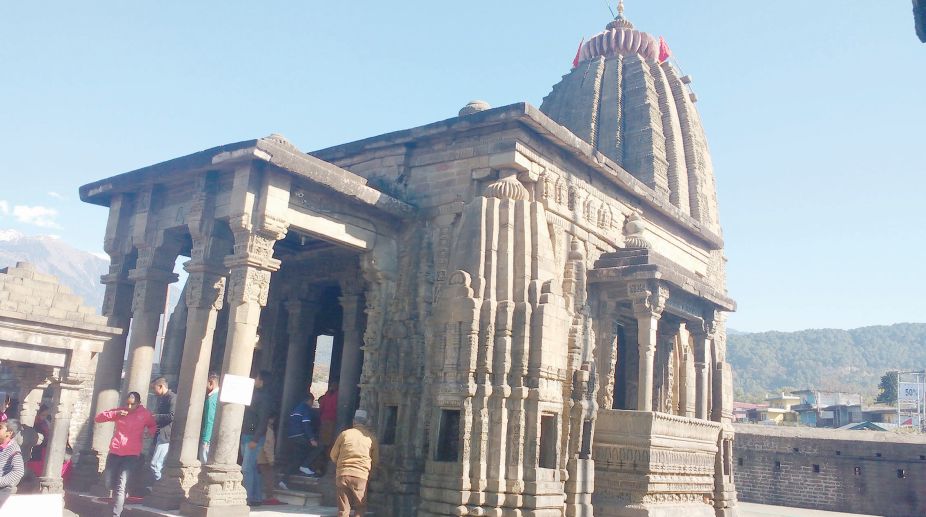Acknowledging the legacy of KG Subramanyan: 100 years and counting
The year 2024 signifies an extraordinary epoch in the annals of art commemorations, marking the 100th birth anniversary of several influential figures in modern Indian art.

Baijnath Shiva Temple
‘Devbhoomi’ Himachal Pradesh is said to be the abode of Gods and Goddesses. The state is a land of numerous pilgrimage centres and several Hindu temples.
The famous Baijnath Shiva Temple at Baijnath in Kangra district is known to be one of the oldest temples of Lord Shiva. At the temple, built in 1204 AD, Lord Shiva is commemorated as Vaidyanath (the Lord of Physicians) and is placed in the form of Lingam (phallic form of Lord Shiva). The Shiva Lingam present here is one of the 12 Jyotirlingas in India.
The Baijnath Shiva temple is located at a distance of 16 kilometres from Palampur. The temple is enclosed by a high wall with entrances in the north and south. It was constructed by two native merchants, Ahuka and Manyuka.
Advertisement
‘The Baijnath temple is always full of devotees.The morning Aarti takes place around 6 a.m. and is when the temple resonates with the clanging of bells and the sound of the conch shell. Early in the morning is the best time to get here, before the town wakes up and the hustle and bustle begins,” said a local resident, Raghubir Sharma.
The Shiva Temple epitomises ancient art and culture through its pristine and spellbinding craftsmanship. The outer walls of the temple have several niches with images of gods and goddesses. It is a beautiful example of early medieval north Indian temple architecture known as the Nagara style of temples.
The Svayambhu form of Sivalinga is enshrined in the sanctum of the temple that has five projections on each side and is surmounted with a tall curvilinear Shikhara. The entrance to the sanctum is through a vestibule that has a large square “Mandapa” in front with two massive balconies in the north and south. There is a small porch in front of the mandapa hall that rests on four pillars in the front preceded by an idol of “Nandi”, the bull, in a small pillared shrine.
‘The water of this temple is believed to contain medicinal properties, which can cure diseases. A large number of tourists and pilgrims from all over India and abroad throng the Baijnath Temple throughout the year and especially during the festive season to have a glimpse of the ruling deity, Lord Shiva. Makara Sankranti, Maha Shivaratri, Vaisakha Sankranti, Shravana Mondays, etc., are celebrated with great zeal and splendour. Also, a five day state level function is held here on Maha Shivratri every year,” said a priest, Suresh Bhardwaj.
There is a beguiling story associated with this temple. According to legend, during the Treta Yug, the demon King Ravana who was a sworn devotee of Lord Shiva, worshipped Him in Kailash and even sacrificed his ten heads in the havan kund to attain immortality. Lord Shiva was impressed and not only restored his beheaded heads but also bestowed him with invincible powers. But Ravana wasn’t satisfied and requested Lord Shiva to come with him to Lanka. Lord Shiva consented to his request and converted himself into a Shivling. However, there was a condition of not putting the Shivling on the ground until they reach Lanka. By the time Ravana reached Baijnath he felt the need to answer nature’s call. On seeing a shepherd, Ravana handed over the Shivling to him and went to relieve himself. The shepherd is believed to be Lord Ganesh. Lord Ganesh intentionally kept the linga on the ground and thus the Shivling got established there and is in the form of Ardhnarishwar (half male & half female). This is how Vaidyanath or Lord Shiva is supposed to have come to Baijnath.
The temple is not only a religious spot but also forms a part of ancient Indian heritage. It provides a blend of medieval northern architecture and divinity.
“The temple premises are spotless and the view from the rear end of the temple is magical.
We are stunned by the unparalleled beauty of this picturesque place and experience serenity by seeking blessings of Lord Shiva.
Also, the historical structure of this temple is astounding to behold,” said a tourist Sachin Ahuja.
Advertisement